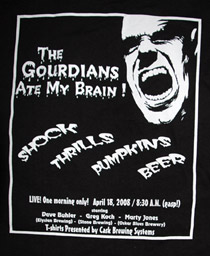To jump start your brain this morning: Two beer posts and a wine link that provoked one of the posts.
Stephen Beaumont on Great Beer vs. Popular Beer.
The number one beer in the United States, for example, is Bud Light, a pale lager with, frankly, some complexity of character, but a flavour profile so that thin it’s almost unnoticeable. This is the choice of the general public, and the general public is well served by it. I am not. I prefer more flavour, more aroma, greater depths and complexities of character and a more notable and lingering aftertaste, and I prefer those general traits in any beer I drink, under any set of circumstances.
Jeff Holt at Wort’s Going on Here? wonders why not a single American macro can get a decent score at the beer rating sites.
So, Corona versus Landshark? On both sites, both beers are rated as “To be Avoided.” Say you are stuck in a resort in Mexico that doesn’t have a beer above 8% ABV, as the top 12 beers on the Beer Advocate list of the top beers. So you can only choose between ten or twelve “D-” beers?
There’s something fundamentally flawed about these beer ratings. Are you telling me that sitting under a Live Oak Tree on a hot, Texas July day a Trappist Westvleteren 12 is better than a cold Budweiser?
And from Eric Asimov of the New York Times, whose notes about the upcoming book “The Wine Trials” provide Beaumont with a starting point. (You’ll want to click over for the entertaining comments — wine people get snippy in such an amusing way.)
In the end, the book seems to divide wine consumers into the casual buyers who are pushed this way and that by forces they don’t understand, and the wealthy conspicuous status seekers who also are not quite aware of capitalism and marketing. Unacknowledged are the serious wine lovers who are knowledgeable, experimental and passionate, and who, yes, are in control of their own destinies.
Perhaps we should be happy beer doesn’t “merit” such serious academic study.
 Morning came way too early Friday at the Craft Brewers Conference, but I was committed to put on a Gourdians T-shirt and make it to the 8:30 presentation titled, “Marketing Outside the Pumpkin.”
Morning came way too early Friday at the Craft Brewers Conference, but I was committed to put on a Gourdians T-shirt and make it to the 8:30 presentation titled, “Marketing Outside the Pumpkin.”